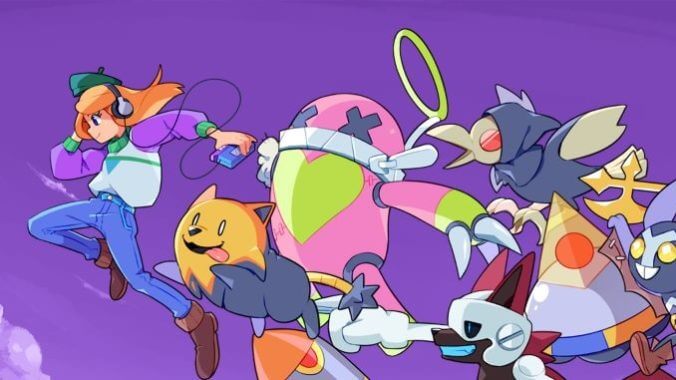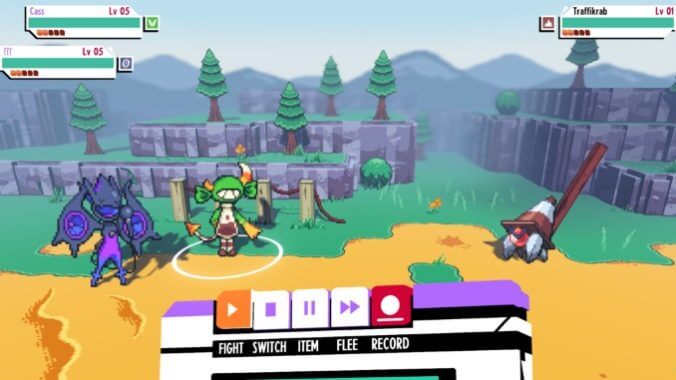
Unbeknownst to me, RPGs in the mold of the Pokémon games have become a very popular subgenre of games over the last several years. Off the top of my head, I can list Coromon, Nexomon: Extinction, and Temtem as just a few of the ones that have popped off in the independent scene in recent memory. On a significantly larger scale, Monster Hunter Stories, a spinoff of the Monster Hunter series, has also been playing within that genre and the Shin Megami Tensei games (which have been doing this longer than Pokémon) are still kicking and more popular than ever thanks to the success of Persona. To say the least, the DNA of Pokémon—already the most successful and recognizable franchise and brand ever—is alive and well even outside of the series. And yet I never played one of these charmingly similar (but legally distinct) monster-collecting games until Cassette Beasts came along.
Cassette Beasts, an “’80s vibe Creature Collector turn-based RPG” developed by Bytten Studio, is the latest of this type of game and blurs the line between them in order to seemingly provide the best of all possible worlds. If you can imagine what those DS-era Pokémon games looked like, then you’ve already honed in on what Cassette Beasts looks like, which delights in this now-retro style. In Cassette Beasts, the monsters you fight and capture are, like its inspiration, drawn from elements of the real world and nature. At one point, a moth that throws out gusts of winds and hands in equal measure did battle with a crab-like street cone called a Traffikrab, which conjured a traffic jam to slow me and my allies in battle. Much of the nuts and bolts under the hood of the game function identically enough that picking up Cassette Beasts is a breeze, but its visual language and tone are distinct enough to make you think twice about writing it off.
The overworld is populated by monsters and other people looking to do battle, and soon enough a structure falls into place where you must fight a dozen or so “captains” who will stamp your page, certifying you as a ranger. You get where all that’s going, though it’s cute and fun to see a game dance around all-too familiar verbiage to land in a similar place. This is about where the similarities end and Cassette Beasts eschewed my expectations.

Almost immediately upon washing up on the shore of New Whirral, an island countless people have just disappeared to that is maybe on Earth, you can run and jump, for example. Over the course of my brief foray into the game, I gained the ability to glide in the overworld thanks to a certain monster I’d recruited, which leaves the door open for other abilities to be unlocked by collecting beasts. Collecting isn’t tied to the inhumane imprisonment of these monsters in a ball (we’re adults who can admit this is pretty fucked up), but is about recording their essence on cassette tape in the midst of battle. Interestingly, capturing is not about weakening enemy monsters to the point of little to no resistance (again, fucked up!) and more about cleverly weighing buffs and debuffs to stave them off while you record them onto a spare tape, allowing you to invoke them as part of your repertoire of creatures. Outside of combat, you’ll befriend other humans who join you in battles and reveal a social link system, which in turn reveals a monster fusion system that runs parallel to it, amplifying the capabilities of the hybrid you and your allies create in battle based on the strength of your relationship!
Battles function differently in Cassette Beasts, switching to an economy that rewards playing smartly and throwing away less moves. Instead of techniques having a certain amount of uses, each one comes with an AP cost, and your monster will gain 2 AP every turn. Some moves, like a buff to your own speed for example, may cost zero AP, allowing you to save AP for a more potent attack on your next turn, while also making a tactical move against your opponent. Using a type advantage in an attack will also debuff the receiving monster, draining the AP they would’ve otherwise gained. This pretty satisfying evolution of combat is necessary too, because by default monsters and humans pack way more of a punch early on, thanks to some intuitive difficulty sliders that dictate AI behavior and level scaling. At its utmost highest, the hardest AI is dubbed “Literally Skynet” while the lowest level scaling option is called “Boring.” While either end is cheekily titled, the spectrum in between shows a significant degree of thought went into making a scalable and accessible title.
What’s best of all is that I’ve merely scratched the surface of Cassette Beasts, and yet it’s easily one of the most promising games I’ve played this year. Chalk it up to any number of the things Cassette Beasts has going for itself, like a style that specifically recalls my childhood or a clever take on a tired battle system. Or maybe, just maybe, it’s the fact that a character calls a bunch of pale real estate suits “vampires.” It’s likely all of the above, but regardless, I’m all in on what this game’s selling me and happy to be surprised along the ride.
Moises Taveras is the assistant games editor for Paste Magazine. He was that one kid who was really excited about Google+ and is still sad about how that turned out.